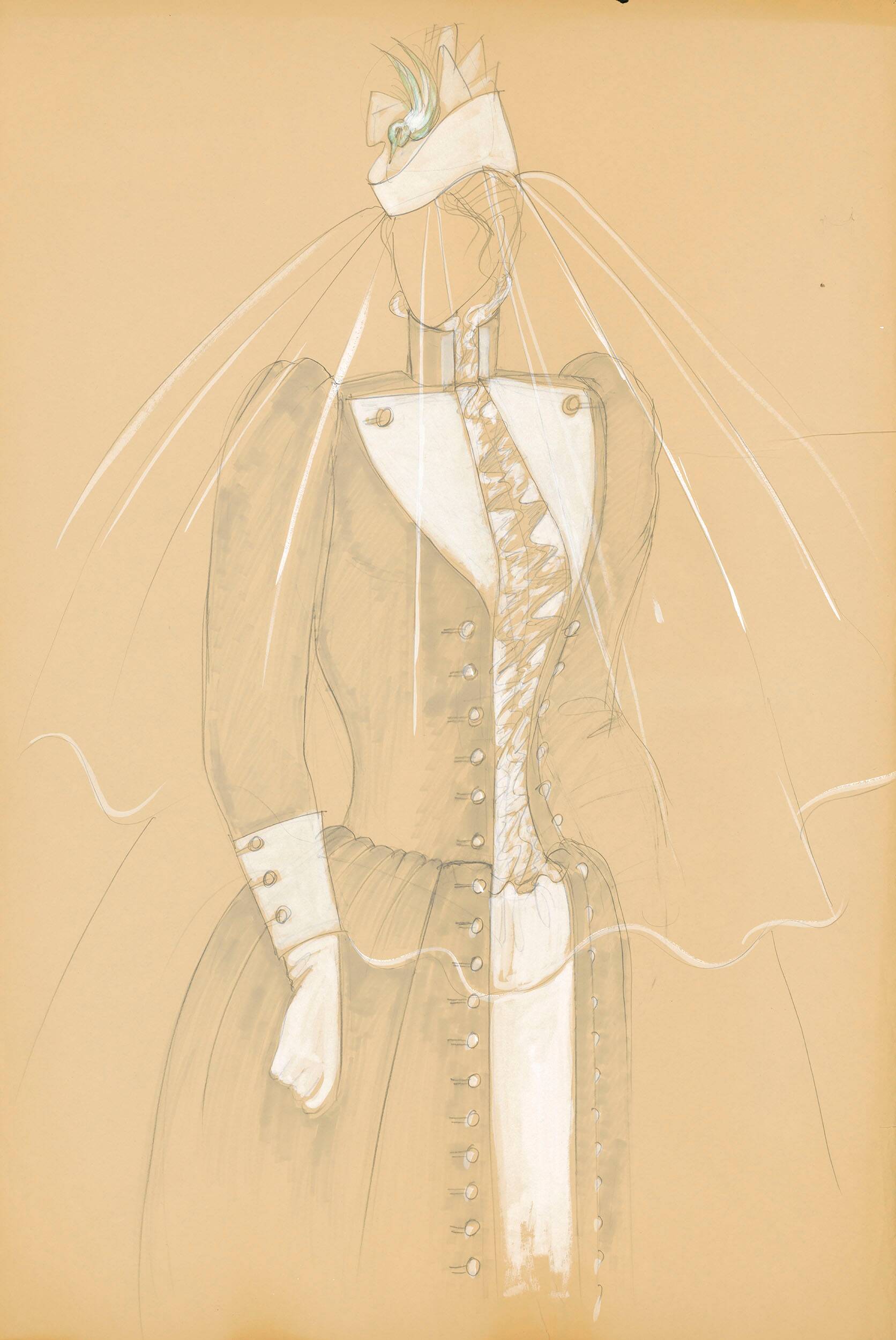
Francis Ford Coppola said that James V. Hart’s script for their 1992 movie Bram Stoker’s Dracula required the costumes to be the set. By collaborating with graphic designer Eiko Ishioka, Coppola fulfilled that vision and their work together resulted in some of the most memorable costumes ever made for these familiar characters.
This was not the Dracula familiar to audiences from earlier Universal and Hammer vampire films. It would be an adaptation of the well-known legend that was told, Ishioka said, as though everyone had taken acid. Her audacious designs provided much of the film’s drama and otherworldliness. Drawing on a deep well of inspiration, the designer chose a rich color palette and sumptuous fabrics that were sculpted into bold forms and patterns embellished with symbolic details.
These drawings, and many more, are part of the Margaret Herrick Library’s Eiko Ishioka papers and can be viewed here.
Coppola and Ishioka had known each other for almost twenty years when he asked her to be the costume designer for his production. In 1979, she designed a striking Japanese poster series for Apocalypse Now and was coincidentally tapped to design the Japanese edition of Eleanor Coppola’s book Notes: On the Making of Apocalypse Now. Five years later, Coppola executive-produced Paul Schrader’s film, Mishima: A Life in Four Chapters, a highly theatrical, historical drama with Ishioka serving as production designer.
They came back together in 1987 when Coppola directed the Rip Van Winkle episode of the television series “Faerie Tale Theatre,” with Ishioka providing the artistic concepts for production designer Michael Erler. Ishioka’s eerie and moody mise-en-scène complements Coppola’s storytelling, and it was due to this personal and professional history that Coppola turned to Ishioka, someone he knew and trusted, once he determined the importance of costumes to his production of Dracula.
Coppola called Ishioka “a weirdo outsider with no roots in the business,” and it is that very quality that sets her work apart. Their collaboration also allowed her to take advantage of her gift for mixing Eastern and Western cultures, and the result is a decadent, surreal atmosphere through which the richly layered mysteries of each character are unveiled.
Determined to modernize the main character, Ishioka transformed one of the story’s most familiar tropes – the black cape that Dracula uses to shield his actions from the eyes of others. Ishioka banished the expected cape and instead costumed Gary Oldman in a crimson red robe that billows behind him as he prowls about his castle.
A fantastic red suit of armor that resembles a flayed human also contributes to his aura of power. The color of both costumes associates him with the blood that he craves.
Nature was a primary source of inspiration for Ishioka, who injected organic details into many of the film’s costumes. For example, Tom Waits’s character Renfield is confined in a mental hospital in a quilted straightjacket constructed of rough gray fabric that makes him look like an insect.
The peppermint-green party dress worn by Sadie Frost’s character, Lucy Westenra, is embroidered with intertwining snakes as a symbol of her character’s eroticism.
Most memorably, Lucy’s spectacular wedding dress was inspired by the Australian frilled lizard, a creature that unfurls a collar of skin when threatened. In Ishioka’s hands, the lace collar creates the illusion that Lucy’s head is disassociated from her body; her jeweled choker draws attention to her neck, the erogenous zone that is the focus of Dracula’s attention.
Lucy’s costumes reflect her wealth and liberal sexual mores and contrast with those of Winona Ryder’s Mina Murray, a middle-class teacher who lacks Lucy’s sophistication. The contrast is perhaps most obvious in the wedding dress that Mina wears to take her vows to Jonathan Harker, played by Keanu Reeves.
Where Lucy’s wedding dress is a study in texture designed to identify her as a creature not wholly human, Mina’s bridal costume is a sedate Victorian-era garment. Rendered in a soft, gray-green fabric, it reveals her character’s modest nature with its high neckline and structured construction. This dress contrasts sharply with the costume she wears when Dracula finally seduces her.
Revealing and blood red, Mina’s dress features an open neckline and three-quarter length sleeves with romantic open cuffs. Ishioka’s color choice ties the two lovers together in a burst of passion that cannot be contained.
Information on the film’s Academy Award® nominations and wins can be found here.

















